Pytorch Learn
Hung-yi Lee
Tensor
Constructor
From list / numpy array
x = torch.tensor([[1,-1],[-1,1]])
x = torch.from_numpy(np.array([[1,-1],[-1,1]]))
Zero tensor
x = torch.zeros([2,2]) # [2,2] is shape
Unit tensor
x = torch.ones([1,2,5]) # [1,2,5] is shape
Operators
Squeeze: remove the specified dimension with length 1
>>> x = torch.zeros([1,2,3])
>>> x.shape
torch.Size([1,2,3])
>>> x = x.squeeze(0) # dim = 0
>>> x.shape
torch.Size([2,3])
Unsqueeze:expand a new dimension
>>> x = torch.zeros([2,3])
>>> x.shape
torch.Size([2,3])
>>> x = x.unsqueeze(1) # dim = 1
>>> shape.shape
torch.Size([2,1,3])
Transpose:transpose two specified dimensions
>>> x = torch.zeros([2,3])
>>> x.shape
torch.Size([2,3])
>>> x = x.transpose(0,1)
>>> x.shape
torch.Size([3,2])
Cat:concatenate multiple tensors
>>> x = torch.zeros([2,1,3]) # dim_1 = 1
>>> y = torch.zeros([2,3,3]) # dim_1 = 3
>>> z = torch.zeros([2,2,3]) # dim_1 = 2
>>> w = torch.cat([x,y,z],dim=1)
>>> w.shape
torch.Size([2,6,3]) # dim_1 = 6
Addition 、Subtraction、Power、Summation、Mean
z = x + y
z = x - y
y = x.pow(2)
y = x.sum()
y = x.mean()
PyTorch v.s. Numpy
Attributes

Shape manipulation

view 方法在改变张量形状时,要求新形状中的元素个数和原形状中的元素个数相同。此外,view 返回的是一个与原张量共享内存的视图。
import torch
# 创建一个 1D 张量
x = torch.arange(6)
print("Original tensor:", x)
# 使用 view 改变形状为 2x3
y = x.view(2, 3)
print("Reshaped using view:", y)
# 修改原张量的值,查看 view 对应的值
x[0] = 10
print("Modified original tensor:", x)
print("View after modifying original:", y)
# Original tensor: tensor([0, 1, 2, 3, 4, 5])
# Reshaped using view: tensor([[0, 1, 2],
# [3, 4, 5]])
# Modified original tensor: tensor([10, 1, 2, 3, 4, 5])
# View after modifying original: tensor([[10, 1, 2],
# [3, 4, 5]])
reshape 方法会返回一个新的张量,它可能会分配新的内存,而不是视图。它也允许一些灵活性,例如在某些情况下改变形状时,reshape 会自动进行内存的调整。
# 使用 reshape 改变形状为 2x3
z = x.reshape(2, 3)
print("Reshaped using reshape:", z)
# 修改原张量的值
x[1] = 20
print("Modified original tensor:", x)
print("Reshape after modifying original:", z)
# Reshaped using reshape: tensor([[10, 1, 2],
# [ 3, 4, 5]])
# Modified original tensor: tensor([10, 20, 2, 3, 4, 5])
# Reshape after modifying original: tensor([[10, 1, 2],
# [ 3, 4, 5]])
Device
Default: tensors & modules will be computed with CPU
CPU :x = x.to('cpu')
GPU : x = x.to('cuda')
Check if your computer has NVIDIA GPU :torch.cuda.is_available()
Multiple GPUs: specify cuda:0, cuda:1, cuda:2, ...
How to Calculate Gradient?
Tensor自动求梯度+计算图模型+反向传播+Function对象
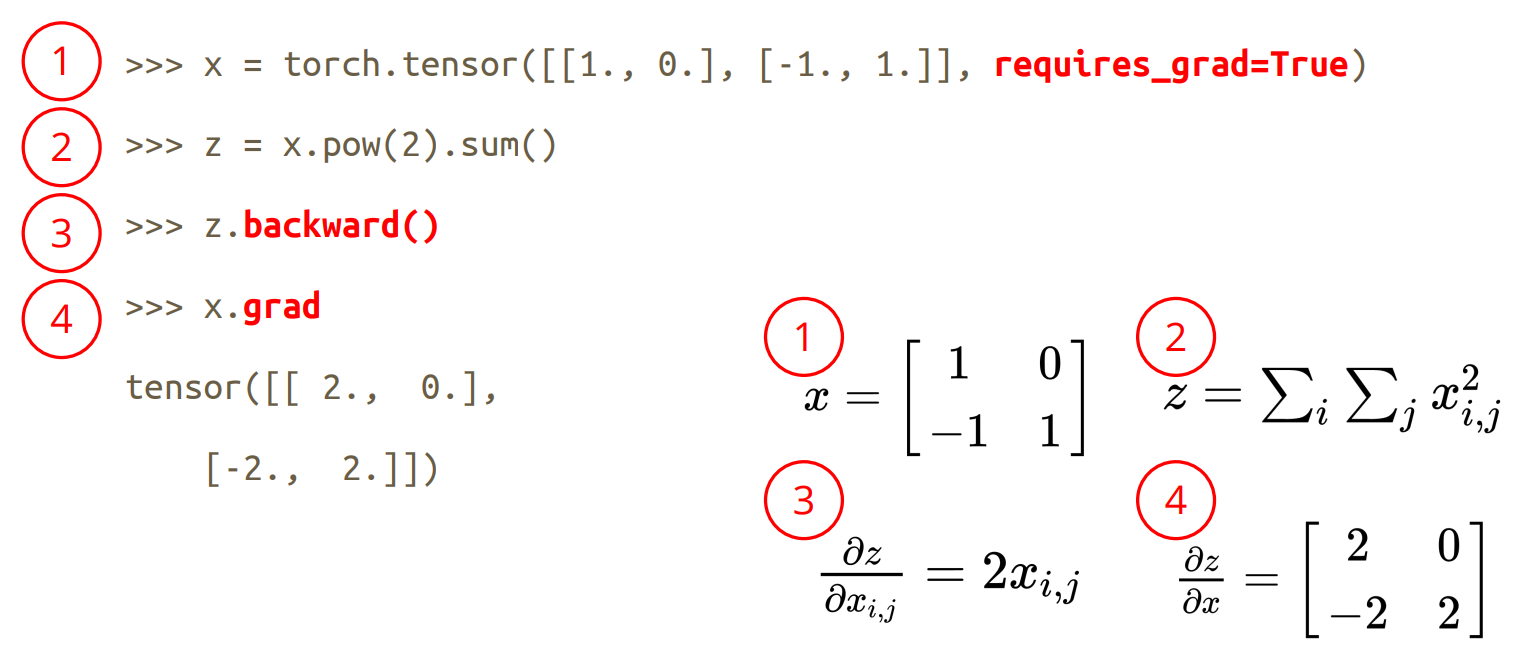
x = torch.tensor([1.0,0.],[-1.,1.],requires_grad=True)
z = x.pow(2).sum()
z.backward()
x.grad
在这段代码中,我们利用 PyTorch 进行自动求梯度,下面详细解释代码的每一个部分及其在反向传播中的作用。同时,我们也将介绍函数对象和叶子节点的概念。
创建张量:
x = torch.tensor([[1.0, 0.], [-1., 1.]], requires_grad=True)- 这里我们创建了一个二维张量
x,其内容是[[1.0, 0.], [-1., 1.]]。 - 设置
requires_grad=True,意味着我们希望跟踪这个张量的操作,以便进行自动求梯度。PyTorch 记录所有对该张量的操作,以便在反向传播时能够计算出梯度。 - 此外,
x是一个叶子节点,这是指在计算图的最底层的张量,它是用户直接创建的张量或从其他张量分割而来,不是通过其他张量的操作结果产生的。
- 这里我们创建了一个二维张量
定义计算图的输出:
z = x.pow(2).sum()x.pow(2)是对x中的每个元素进行平方运算,生成一个新的张量,这个新张量并不是用户直接创建的,而是通过操作x生成,因此它不是叶子节点。- 接着,我们调用
.sum(),它会计算所有元素的和,结果保存在z中。至此,计算图已经构建完成,PyTorch 知道如何从z计算回x。
反向传播:
z.backward()
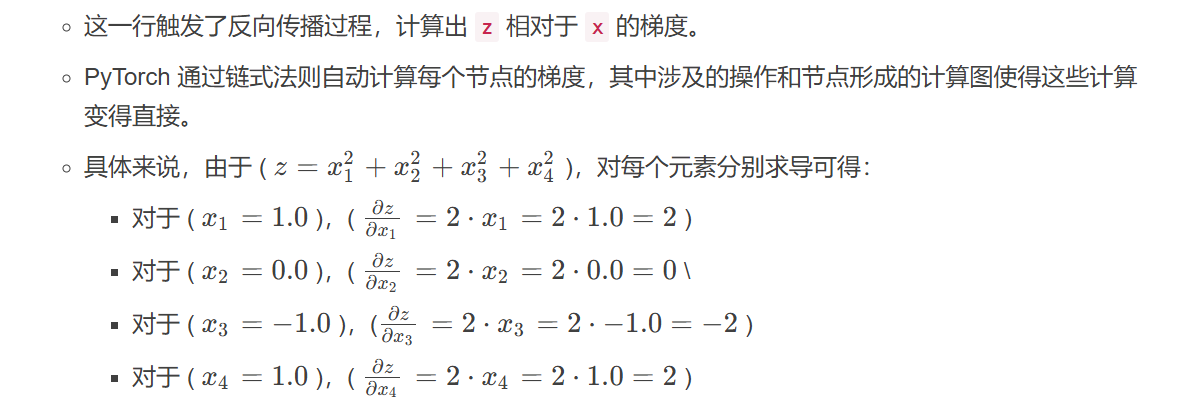
查看梯度:
x.grad- 这一行返回
x的梯度,结果应为:tensor([[ 2., 0.], [-2., 2.]])。这对应于从反向传播过程中计算得到的梯度值。
- 这一行返回
- 在 PyTorch 中,任何通过运算生成的张量都可以看作是一个函数对象,它们代表了多个操作和计算结果的链表。例如,
z就是一个非叶子节点,它由x计算得到,而这些操作形成了一个计算图,这样在计算梯度时,我们就知道如何回溯。
Note 1:
从数据加载器(DataLoader)中得到的Tensor默认情况下其
requires_grad属性是False,这意味着这些Tensor在反向传播时不会计算梯度。这是因为输入数据通常不需要计算梯度,只有模型的参数(如权重和偏置)需要计算梯度以进行优化。在计算损失的过程中,只有那些需要更新的模型参数(通常是权重,
weight)的requires_grad属性设置为True。这些参数在反向传播时会计算梯度,以便优化算法(如SGD、Adam等)可以使用这些梯度来更新模型参数。整个过程可以简要总结如下:
- 数据 Tensor 的
requires_grad默认是False,用于输入数据。- 模型参数(如权重)一般设置为
requires_grad=True,以计算梯度。- 损失函数的计算图仅涉及那些
requires_grad=True的参数,进行反向传播时会计算梯度。Note 2:
在 PyTorch 中,训练模型时传给损失函数(loss function)的参数通常是模型的输出(即预测值)和目标值(即真实标签)。从构建
Function对象并用于反向传播的角度,我们可以更详细地理解这一过程。首先,我们通过前向传播过程得到模型的输出,通常如下所示:
output = model(input_data)output中是通过前向传播得来的,这个过程构建了计算图模型是一个Fucition对象,其中requires_grad=True的只有weight和bias这些parameter
在计算损失时,我们将模型输出和目标值传递给损失函数。例如,对于分类问题,常用的损失函数是
CrossEntropyLoss:loss = loss_fn(output, target)在 PyTorch 的底层,损失函数的计算是通过定义
Function类来实现的。每个损失函数都会有一个与之关联的Function对象,它定义了前向传播(forward)和反向传播(backward)的方法。
前向传播:在前向传播时,损失函数将模型输出和目标值作为输入,计算损失值。这一过程记录了计算图的结构和数据流向。
反向传播:在反向传播时(当调用
loss.backward()时),PyTorch 会使用在前向传播中记录的计算图来计算梯度。在这个过程中,框架会调用损失函数对应的backward方法,损失的梯度(对模型输出的梯度)会被传递回去,这个过程涉及计算链式法则,最终所有requires_grad=True的参数(如模型权重)都能得到相应的梯度。在得到梯度后,我们使用优化器(如 SGD 或 Adam)来更新模型的参数。这一过程使用到计算过程中得到的梯度值。
optimizer.zero_grad() # 清除之前的梯度 loss.backward() # 反向传播,计算梯度 optimizer.step() # 更新参数
Overview of the DNN Training Procedure

Dataset & Dataloader
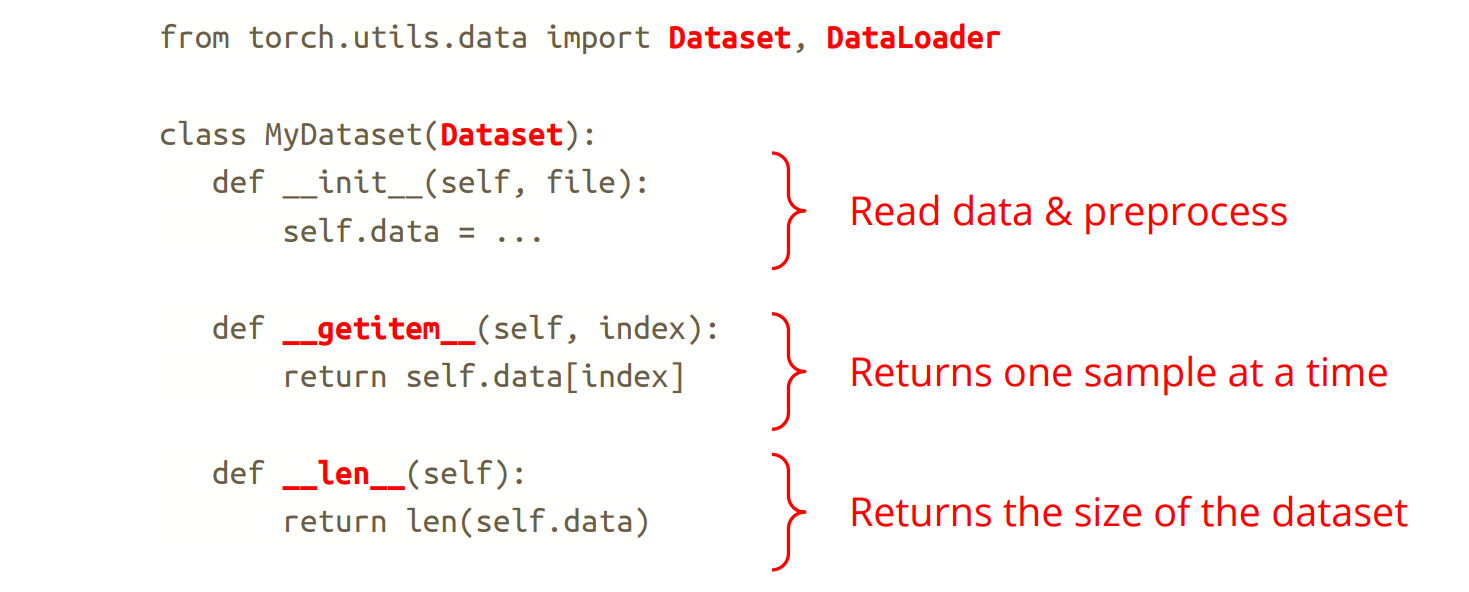

torch.nn
Neural Network Layers
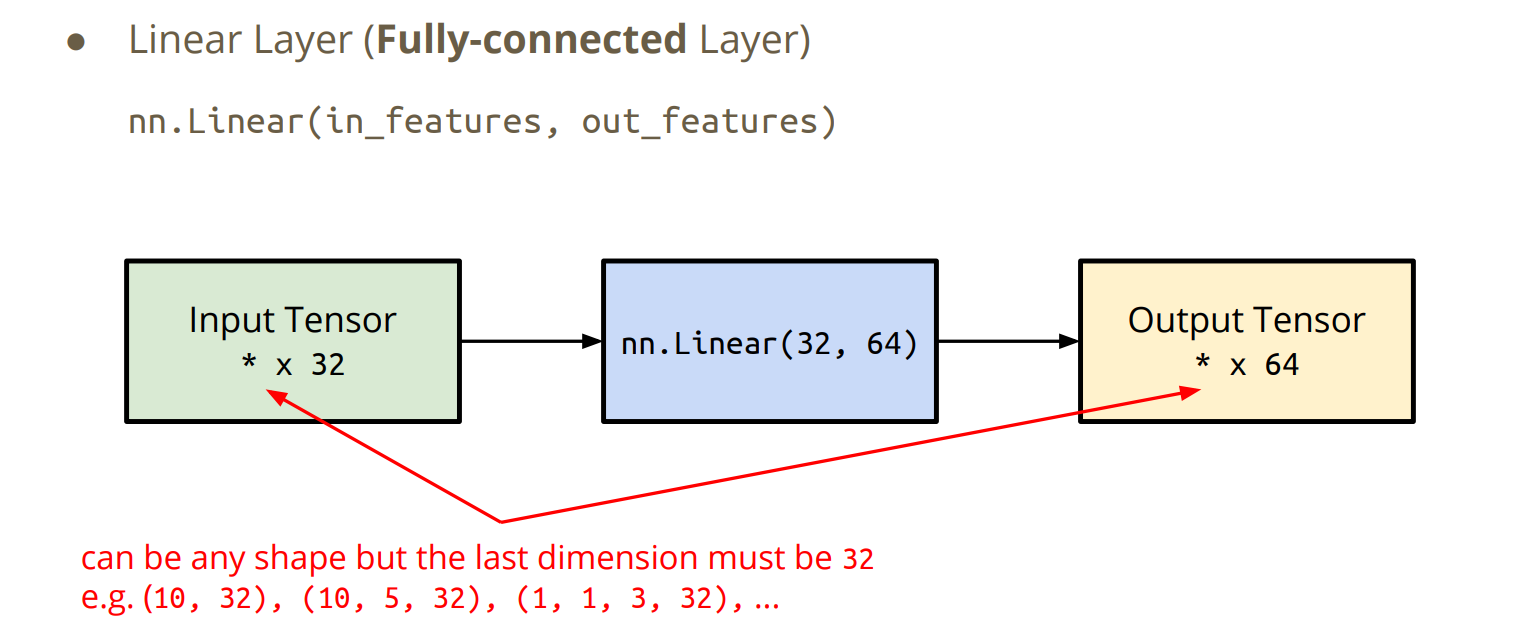


nn.Module
Sequential接收一个 “子模块的有序字典(OrderedDict)”或者“一系列子模块”作为参数来逐一添加 Module 的实例,得到模型的forward 方法将这些实例按添加的顺序逐一计算,适用于模型的前向计算为简单串联各个层的计算的情况.
net = nn.Sequential(
nn.Linear(784, 256),
nn.ReLU(),
nn.Linear(256, 10),
)
ModuleList 接收一个子模块的列表作为输入,可以类似 python List 那样进行 append 和 extend 操作
class MyModule(nn.Module):
def __init__(self):
super(MyModule, self).__init__()
self.linears = nn.ModuleList([nn.Linear(10, 10) for i in range(10)])
def forward(self, x):
# ModuleList can act as an iterable, or be indexed using ints
for i, l in enumerate(self.linears):
x = self.linears[i // 2](x) + l(x)
return x
ModuleDict 也是为了让网络定义 forward 时更加灵活而出现的,它接受一个子模块的字典作为输入,可以类似 python Dict 那样进行添加访问操作
net = nn.ModuleDict({
'linear': nn.Linear(784, 256),
'act': nn.ReLU(),
})
net['output'] = nn.Linear(256, 10) # 类似 python Dict 进行添加
print(net['linear']) # 类型 python Dict 进行访问
print(net.output) # 另一种访问 key 'output' 的方法
print(net)
# net(torch.zeros(1, 784)) # 报NotImplementedError
# Linear(in_features=784, out_features=256, bias=True)
# Linear(in_features=256, out_features=10, bias=True)
# ModuleDict(
# (linear): Linear(in_features=784, out_features=256, bias=True)
# (act): ReLU()
# (output): Linear(in_features=256, out_features=10, bias=True)
# )
Activation Functions

Loss Functions

Build own neural network
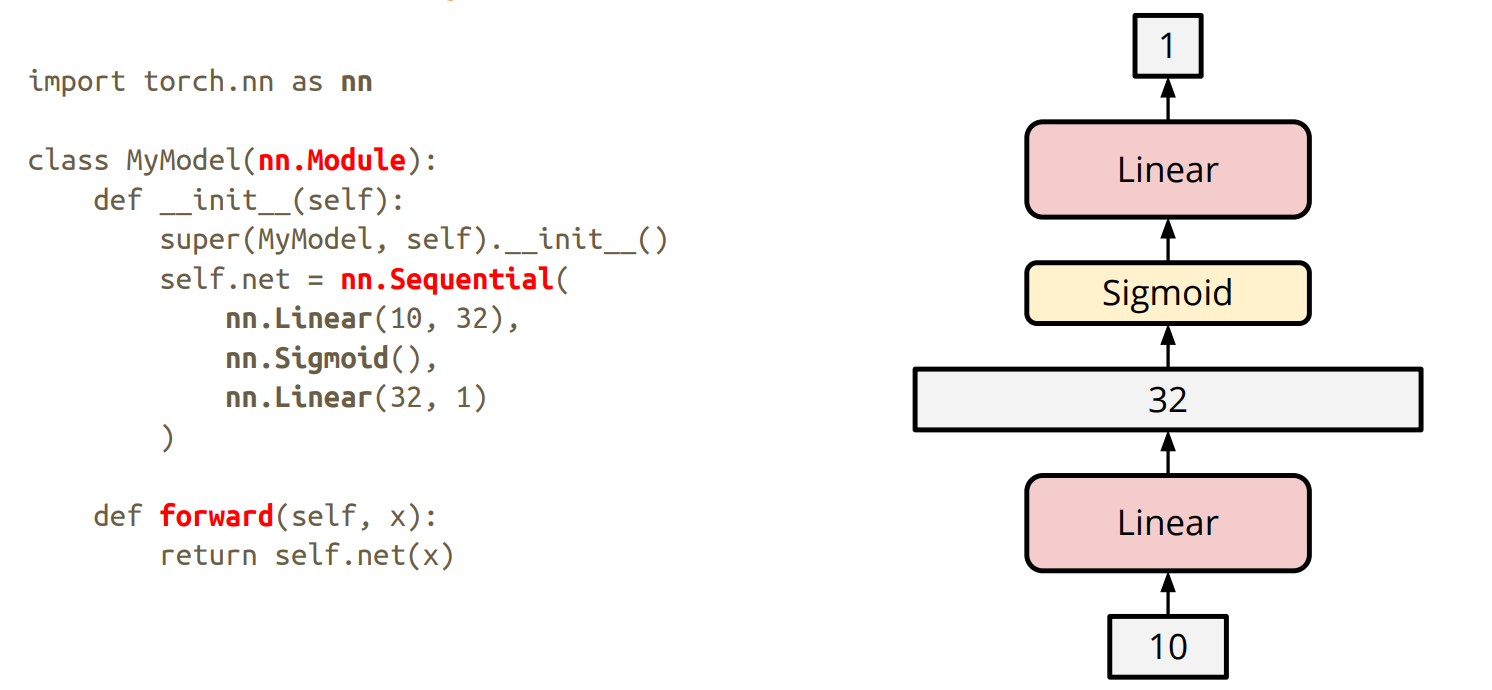
torch.optim
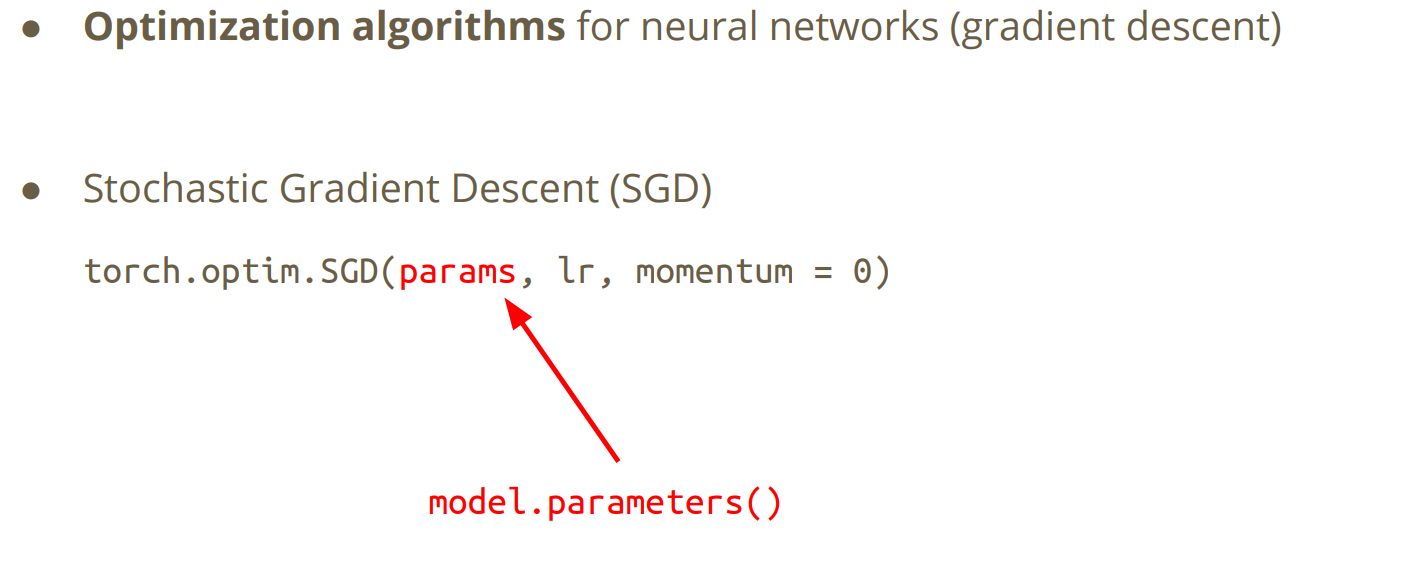
Neural Network Training

Neural Network Training

Neural Network Evaluation (Validation Set)
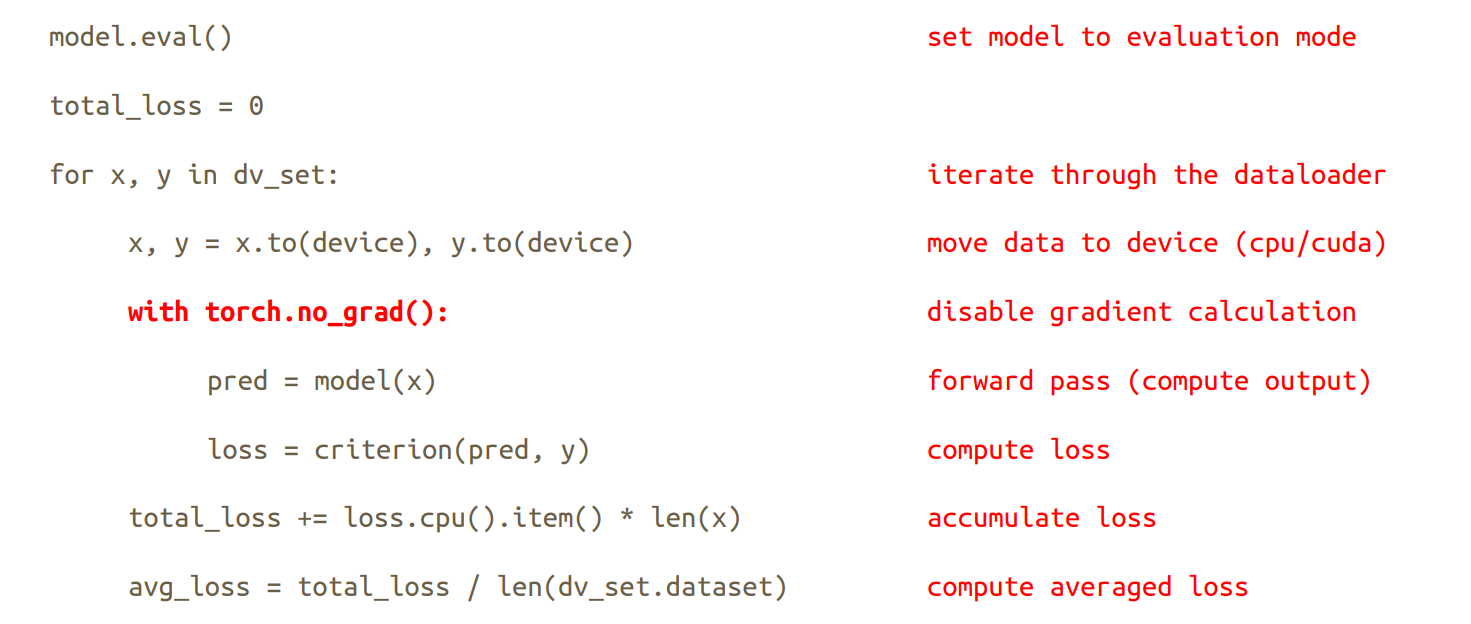
Neural Network Evaluation (Testing Set)
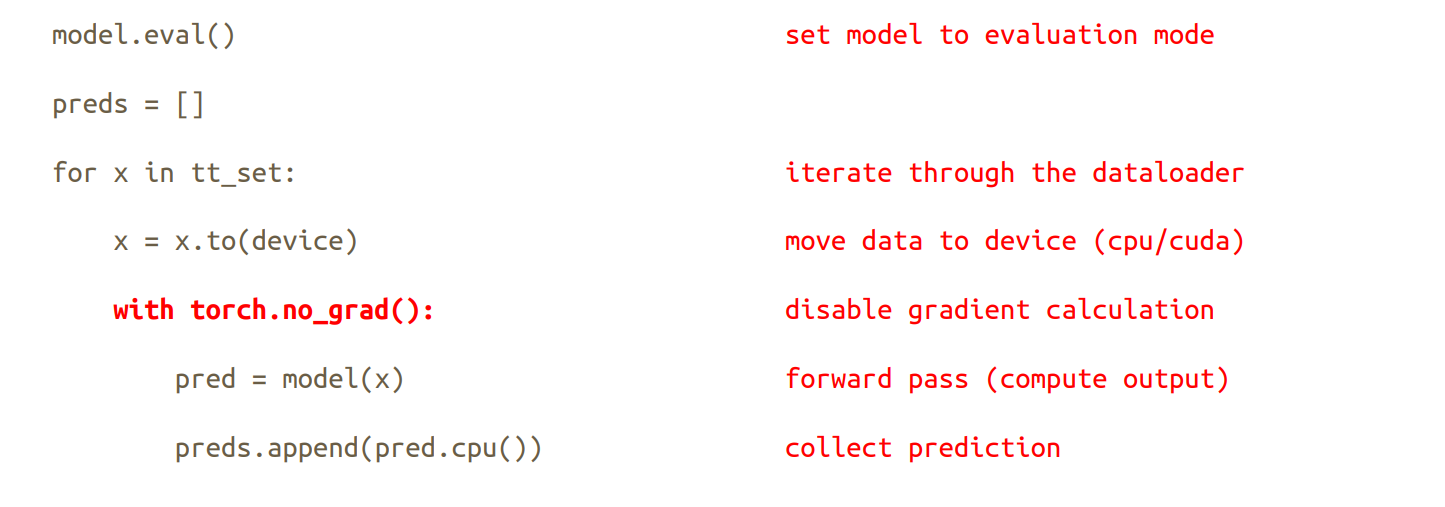
Save/Load a Neural Network

